Effects of Plasma and Activated Water on Biological Characteristics of Bromus inermis Seeds Under Different Power Supply Excitation
Abstract
1. Introduction
2. Materials and Methods
2.1. Experimental Setup
2.2. Experimental Process
2.3. Determination of Plant Seed Biological Characteristics
2.3.1. Contact Angle Measurement
2.3.2. Germination Percentage
2.3.3. Determination of RONS Concentrations in PAW
2.3.4. Determination of Antioxidant Enzyme Activities
3. Experimental Results
3.1. Discharge Characteristics
3.2. Contact Angle and Germination Percentage Under Different Treatments
- DC Plasma Treatment
- 2.
- Pulsed Plasma Treatment
- Control group: Initial contact angle 89° ± 1.5 indicates intrinsic hydrophobicity;
- DC-optimal group (15 kV/10 min): Angle further decreased to 36.7° ± 0.5, significantly surpassing pulsed group;
- Pulsed-optimal group (14 kV/6 kHz/2500 ns/10 min): Angle reduced to 38° ± 0.8 attributed to micro-nano structures and polar groups induced by periodic plasma impulses.
3.3. Trends in PAW
- Effect of Treatment Time as shown in Figure 6A:
- Effect of Treatment Voltage as shown in Figure 6B:
3.4. Seedling Growth
- PAW biomass superiority: Fresh weight 44.5 mg (+60%), dry weight 7.0 mg (+27%), indicating enhanced photosynthesis.Unchanged root length but higher biomass suggests lateral root proliferation.
- Pulsed root specificity: Root length 11.5 mm (+21%) due to ROS-activated auxin polar transport.No biomass gain implies energy allocation to elongation over accumulation.
- DC contradiction: Temporary height increase (40.0 mm) with low dry matter conversion (unchanged dry weight).
3.5. Measurement of Enzyme Activity in Seedlings
3.5.1. Changes in Antioxidant Enzyme Activity
3.5.2. Photosynthetic Pigments and Metabolic Activities
4. Discussion
5. Conclusions
- (1)
- Different power sources and voltage parameters have distinct effects on seeds. The optimal conditions for direct current (DC) treatment were 15 kV for 10 min; for pulsed treatment, 15 kV, 6 kHz, 2500 ns, and 10 min; and for PAW treatment, 15 kV for 10 min.
- (2)
- Discharge plasma treatment can break seed dormancy and promote germination. Among the three treatments, PAW showed the most significant increase in germination percentage, with a 50% improvement. The pulsed treatment group saw an 18% increase, while the DC treatment group had a 16% increase.
- (3)
- Discharge plasma treatment can enhance seed germination and promote growth. Regarding the activities of SOD, POD, and CAT, PAW demonstrated the most pronounced effects, with increases of 117%, 46%, and 65%, respectively. In contrast, the effects of DC and pulsed treatments were relatively similar, with SOD increasing by 42% in both cases and POD, DC increased by 22%. Pulse slightly decreased, while CAT decreased in both treatments.
Author Contributions
Funding
Institutional Review Board Statement
Informed Consent Statement
Data Availability Statement
Acknowledgments
Conflicts of Interest
References
- Thirumdas, R.; Kothakota, A.; Annapure, U.; Siliveru, K.; Blundell, R.; Gatt, R.; Valdramidis, V.P. Plasma activated water (PAW): Chemistry, physico-chemical properties, applications in food and agriculture. Trends Food Sci. Technol. 2018, 77, 21–31. [Google Scholar] [CrossRef]
- Paulikienė, S.; Benesevičius, D.; Benesevičienė, K.; Ūksas, T. Review—Seed Treatment: Importance, Application, Impact, and Opportunities for Increasing Sustainability. Agronomy 2025, 15, 1689. [Google Scholar] [CrossRef]
- Rathore, V.; Tiwari, B.S.; Nema, S.K. Treatment of Pea Seeds with Plasma Activated Water to Enhance Germination, Plant Growth, and Plant Composition. Plasma Chem. Plasma Process. 2022, 42, 109–129. [Google Scholar] [CrossRef]
- Song, Z.; Ding, C.; Luan, X.; Chen, H. Review of research on biological effects of high-voltage corona electric field. J. Nucl. Agric. 2019, 33, 69–75. [Google Scholar]
- Gu, T.; Bao, S.H.; Miao, Y.J. Study on Seed Germination and Physiological Adaptability of Three Grasses to Diurnal Temperature Change in Alpine Region. Acta Agrestia Sinica. 2025, 1–14. Available online: https://link.cnki.net/urlid/11.3362.S.20250611.1012.002 (accessed on 13 June 2025).
- Mai-prochnow, A.; Zhou, R.W.; Zhang, T.; Ostrikov, K.; Mugunthan, S.; Rice, S.A.; Cullen, P.J. Interactions of plasma-activated water with biofilms: Inactivation, dispersal effects and mechanisms of action. npj Biofilms Microbiomes 2021, 7, 11. [Google Scholar] [CrossRef]
- Kaushik, N.K.; Ghimire, B.; Li, Y.; Adhikari, M.; Veerana, M.; Kaushik, N.; Jha, N.; Adhikari, B.; Lee, S.-J.; Masur, K.; et al. Biological and medical applications of plasma-activated media, water and solutions. Biol. Chem. 2018, 400, 39–62. [Google Scholar] [CrossRef]
- Grainge, G.; Nakabayashi, K.; Steinbrecher, T.; Kennedy, S.; Ren, J.; Iza, F.; Leubner-Metzger, G. Molecular mechanisms of seed dormancy release by gas plasma-activated water technology. J. Exp. Bot. 2022, 73, 4065–4078. [Google Scholar] [CrossRef]
- Shao, T.; Wang, R.; Zhang, C.; Yan, P. Atmospheric-pressure pulsed gas discharge and pulsed plasma application. High Volt. Eng. 2016, 42, 685–705. [Google Scholar]
- Liu, M.; Tang, J.; Pan, C. Experimental study on the development process of DC positive and negative corona on needle plates in air. High Volt. Eng. 2016, 42, 1018–1027. [Google Scholar]
- Li, M.; Wang, X.; Zhao, Y. Influence of nano second pulse voltage amplitude and rising/falling ddge time on the uniformity of atmospheric pressure N2 DBD. High Volt. Eng. 2024, 50, 852–860. [Google Scholar]
- Bailly, C. Active oxygen species and antioxidants in seed biology. Seed Sci. Res. 2004, 14, 93–107. [Google Scholar] [CrossRef]
- Gong, B.; Yan, Y.; Zhang, L.; Cheng, F.; Liu, Z.; Shi, Q. Unravelling GSNOR-Mediated S-Nitrosylation and Multiple Developmental Programs in Tomato Plants. Plant Cell Physiol. 2019, 60, 2523–2537. [Google Scholar] [CrossRef]
- Laurita, R.; Barbieri, D.; Gherardi, M.; Colombo, V.; Lukes, P. Chemical analysis of reactive species and antimicrobial activity of water treated by nano second pulsed DBD air plasma. Clin. Plasma Med. 2015, 3, 53–61. [Google Scholar] [CrossRef]
- Man, C.; Huang, B.; Zhang, C. Reactive nitrogen species characteristic of plasma-activated water under different pulsed parameters. High Volt. Eng. 2022, 48, 2326–2335. [Google Scholar]
- Jiang, J.; He, X.; Li, L.; Li, J.; Shao, H.; Xu, Q.; Ye, R.; Dong, Y. Effect of cold plasma treatment on seed germination and growth of wheat. Plasma Sci. Technol. 2014, 16, 54–58. [Google Scholar] [CrossRef]
- Vichiansan, N.; Chatmaniwat, K.; Sungkorn, M.; Leksakul, K.; Chaopaisarn, P.; Boonyawan, D. Effect of plasma-activated water generated using plasma jet on tomato (Solanum lycopersicum L. var. cerasiforme) seedling growth. J. Plant Growth Regul. 2023, 42, 935–945. [Google Scholar] [CrossRef]
- Li, P.; Tao, H.; Peng, C. Effects of DBD plasma and activated water on potato growth characteristics and yield. High Volt. Eng. 2024, 50, 1742–1751. [Google Scholar]
- Pang, B.; Gao, Y.; Liu, Z. pH-mediated regulation of chemical activity and anticancer effects in plasma activated water. High Volt. Eng. 2025, 51, 2914–2924. [Google Scholar] [CrossRef]
- Yang, H.; Jiang, N.; Sun, H. Study on the Preparation of Activated Water by Carbon Cloth-covered Reinforced Falling Film DBD Plasma. High Volt. Eng. 2025, 51, 2925–2933. [Google Scholar] [CrossRef]
- Jiao, Z.M.; Yang, X.; Song, R. Study on the dormancy characteristics and breaking methods of Hypericum perforatum seeds. Seed 2025, 44, 16–25+35. [Google Scholar]
- Priatama, R.A.; Pervitasari, A.N.; Park, S.; Park, S.J.; Lee, Y.K. Current Advancements in the Molecular Mechanism of Plasma Treatment for Seed Germination and Plant Growth. Int. J. Mol. Sci. 2022, 23, 4609. [Google Scholar] [CrossRef]
- Li, Y.; Wang, T.; Meng, Y.; Qu, G.; Sun, Q.; Liang, D.; Hu, S. Air atmospheric dielectric barrier discharge plasma induced germination and growth enhancement of wheat seed. Plasma Chem. Plasma Process 2017, 37, 1621–1634. [Google Scholar] [CrossRef]
- Liu, Z.; Zhou, C.; Liu, D.; He, T.; Guo, L.; Xu, D.; Kong, M.G. Quantifying the concentration and penetration depth of long-lived RONS in plasma-activated water by UV absorption spectroscopy. AIP Adv. 2019, 9, 015014. [Google Scholar] [CrossRef]
- Lu, X.; Wu, S.; Wang, S. Effect of high voltage electrode covering dielectric on bubble discharge characteristics and plasma-liquid interaction. High Volt. Eng. 2023, 49, 3305–3314. [Google Scholar]
- Wang, Q.-H.; Yu, L.-J.; Liu, Y.; Lin, L.; Lu, R.-G.; Zhu, J.-P.; He, L.; Lu, Z.-L. Methods for the detection and determination of nitrite and nitrate: A review. Talanta 2017, 165, 709–720. [Google Scholar] [CrossRef]
- Bader, H. Determination of Ozone In Water By The Indigo Method: A Submitted Standard Method. Ozone Sci. Eng. 1982, 4, 169–176. [Google Scholar] [CrossRef]
- Zhang, X.; Guo, Y.; Sun, A.; Yao, C.; Sun, G.; Zhang, G. The pulsed mode of negative DC corona in nitrogen at atmosphere pressure: Comparison with Trichel pulses in air. Phys. Plasmas 2020, 27, 033501. [Google Scholar] [CrossRef]
- Ferreira, N.G.C.; Almeida, P.G.; Eivazpour Taher, A.; Naidis, G.V.; Benilov, M.S. Numerical investigation of stability of low-current needle-to-plane negative corona discharges in air. Plasma Sources Sci. Technol. 2025, 34, 085002. [Google Scholar] [CrossRef]
- Hoffer, P.; Niedoba, K.; Jirásek, V.; Prukner, V.; Šimek, M. Streamer-based discharge on water–air interface as a source of plasma-activated water: Conceptual design and basic performance. Plasma Chem. Plasma Process. 2023, 43, 1531–1547. [Google Scholar] [CrossRef]
- Voráč, J.; Synek, P.; Procházka, V.; Hoder, T. State-by-state emission spectra fitting for non-equilibrium plasmas: OH spectra of surface barrier discharge at argon/water interface. J. Phys. D Appl. Phys. 2017, 50, 294002. [Google Scholar] [CrossRef]
- Guragain, R.P.; Kierzkowska-Pawlak, H.; Fronczak, M.; Kędzierska-Sar, A.; Subedi, D.P.; Tyczkowski, J. Germination improvement of fenugreek seeds with cold plasma: Exploring long-lasting effects of surface modification. Sci. Hortic. 2024, 324, 112619. [Google Scholar] [CrossRef]
- Camut, L.; Gallova, B.; Jilli, L.; Sirlin-Josserand, M.; Carrera, E. Sakvarelidze-Achard. Nitrate signaling promotes plant growth by upregulating gibberellin biosynthesis and destabilization of DELLA proteins. Curr. Biol. 2021, 31, 4971–4982. [Google Scholar] [CrossRef] [PubMed]
- Pandey, S.; Mishra, R.; Mishra, A.; Jangra, S.; Prakash, R. Plasma activated water generation in pin-to-plate gas phase DBD-based plasma source for enhanced biochemical activity. Phys. Lett. A 2025, 535, 130245. [Google Scholar] [CrossRef]
- Zhang, M.; Li, D.C.; Li, C. Research progress in the application of lon wind Trans. China Electrotech. Soc. 2021, 36, 2749–2766. [Google Scholar]
- Ali, Q.; Daud, M.K.; Haider, M.Z.; Ali, S.; Rizwan, M.; Aslam, N.; Noman, A.; Iqbal, N.; Shahzad, F.; Deeba, F.; et al. Seed priming by sodium nitroprusside improves salt tolerance in wheat (Triticum aestivum L.) by enhancing physiological and biochemical parameters. Plant Physiol. Biochem. 2017, 119, 50–58. [Google Scholar] [CrossRef] [PubMed]
- Kuang, Y.; Zhang, C.; Hu, X.; Ren, C.; Chen, G.; Shao, T. Factors influencing nitrogen fixation by microbubbles coupled with nanosecond-pulse liquid phase discharges. Trans. China Electrotech. Soc. 2023, 38, 3960–3971. [Google Scholar]
- Kooshki, S.; Pareek, P.; Janda, M.; Machala, Z. Selective reactive oxygen and nitrogen species production in plasma-activated water via dielectric barrier discharge reactor: An innovative method for tuning and its impact on dye degradation. J. Water Process Eng. 2024, 63, 105477. [Google Scholar] [CrossRef]
- Ranieri, P.; Sponsel, N.; Kizer, J.; Rojas-Pierce, M.; Hernández, R.; Gatiboni, L.; Grunden, A.; Stapelmann, K. Plasma agriculture: Review from the perspective of the plant and its ecosystem. Plasma Process Polym. 2021, 18, 2000162. [Google Scholar] [CrossRef]
- Guan, J.Y.; Zhang, Q.Y. Effects of different acid treatments on red raspberry seed germination. South China Fruits 2022, 51, 225–227+234. [Google Scholar]
- Asghari, A.; Sabbaghtazeh, E.; Milani, N.R.; Kouhi, M.; Maralani, A.A.; Gharbani, P.; Khiaban, A.S. Effects of plasma-activated water on germination and initial seedling growth of wheat. PLoS ONE 2025, 20, e0312008. [Google Scholar] [CrossRef] [PubMed]
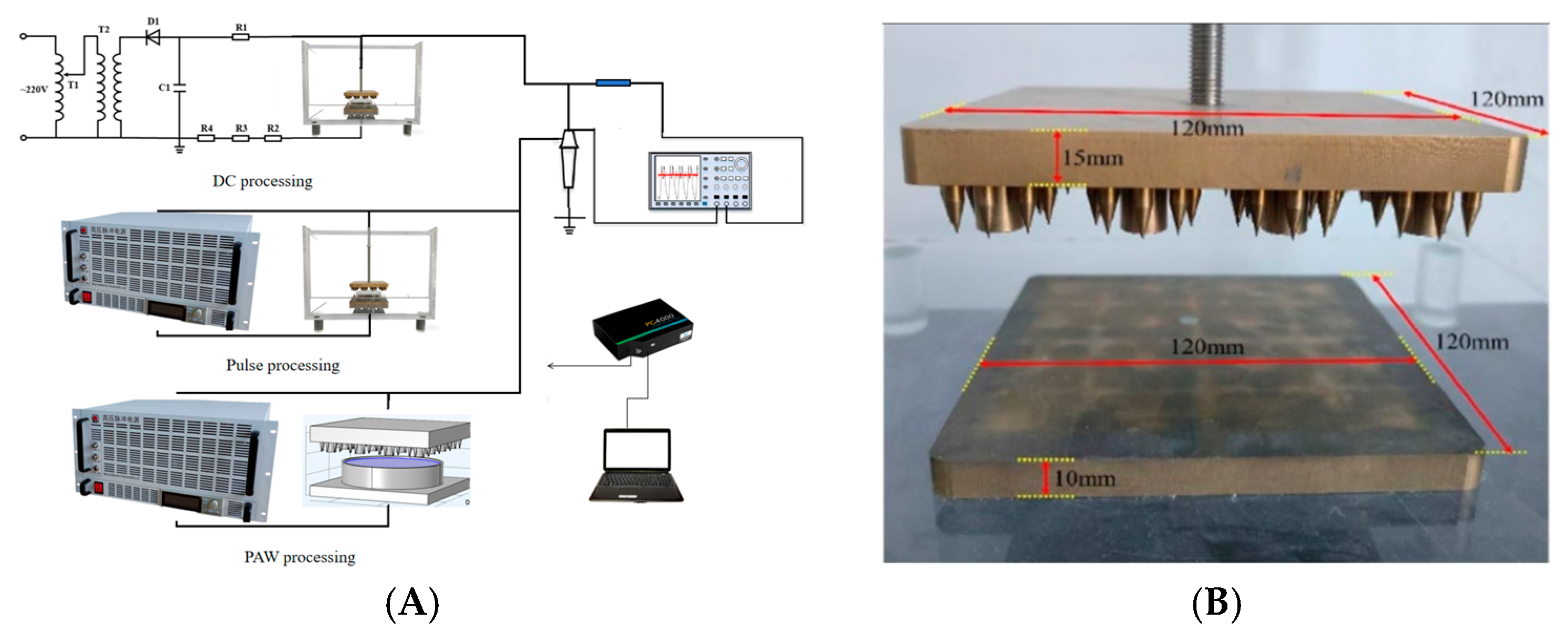

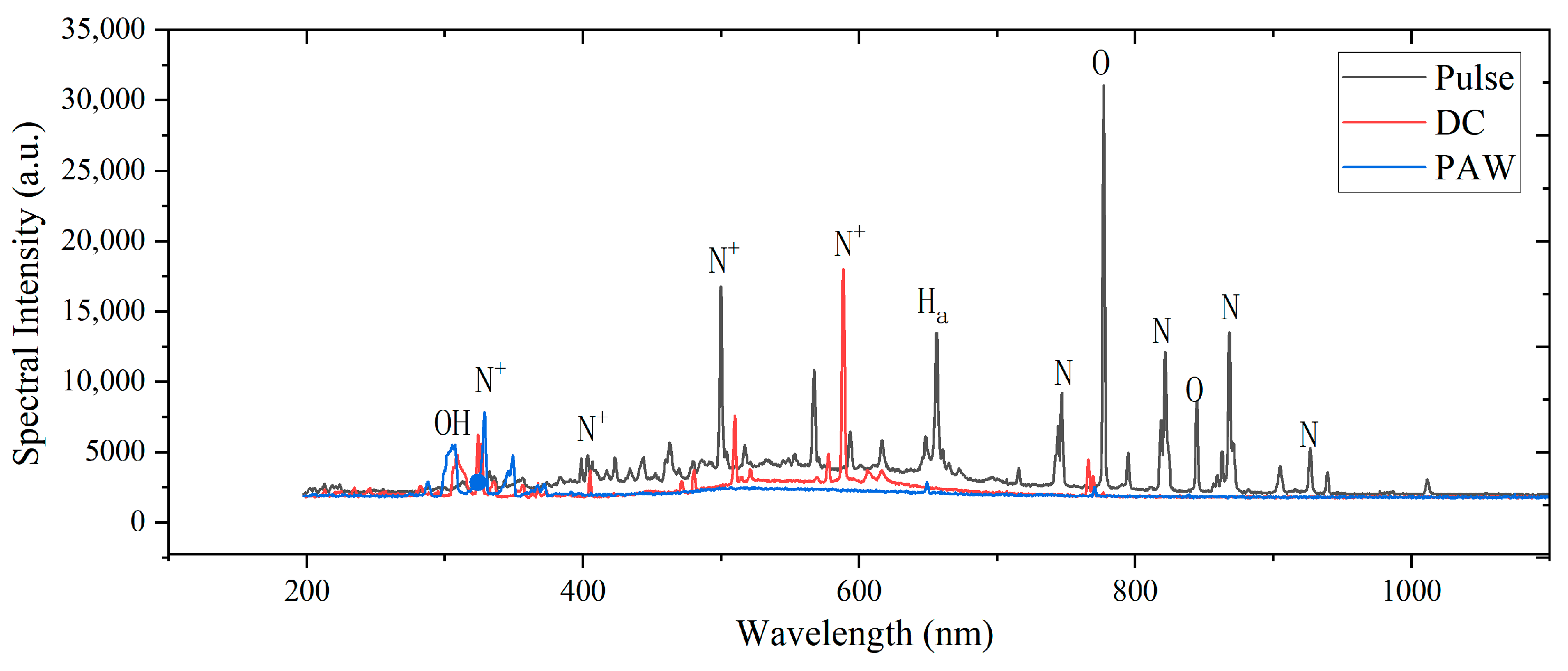
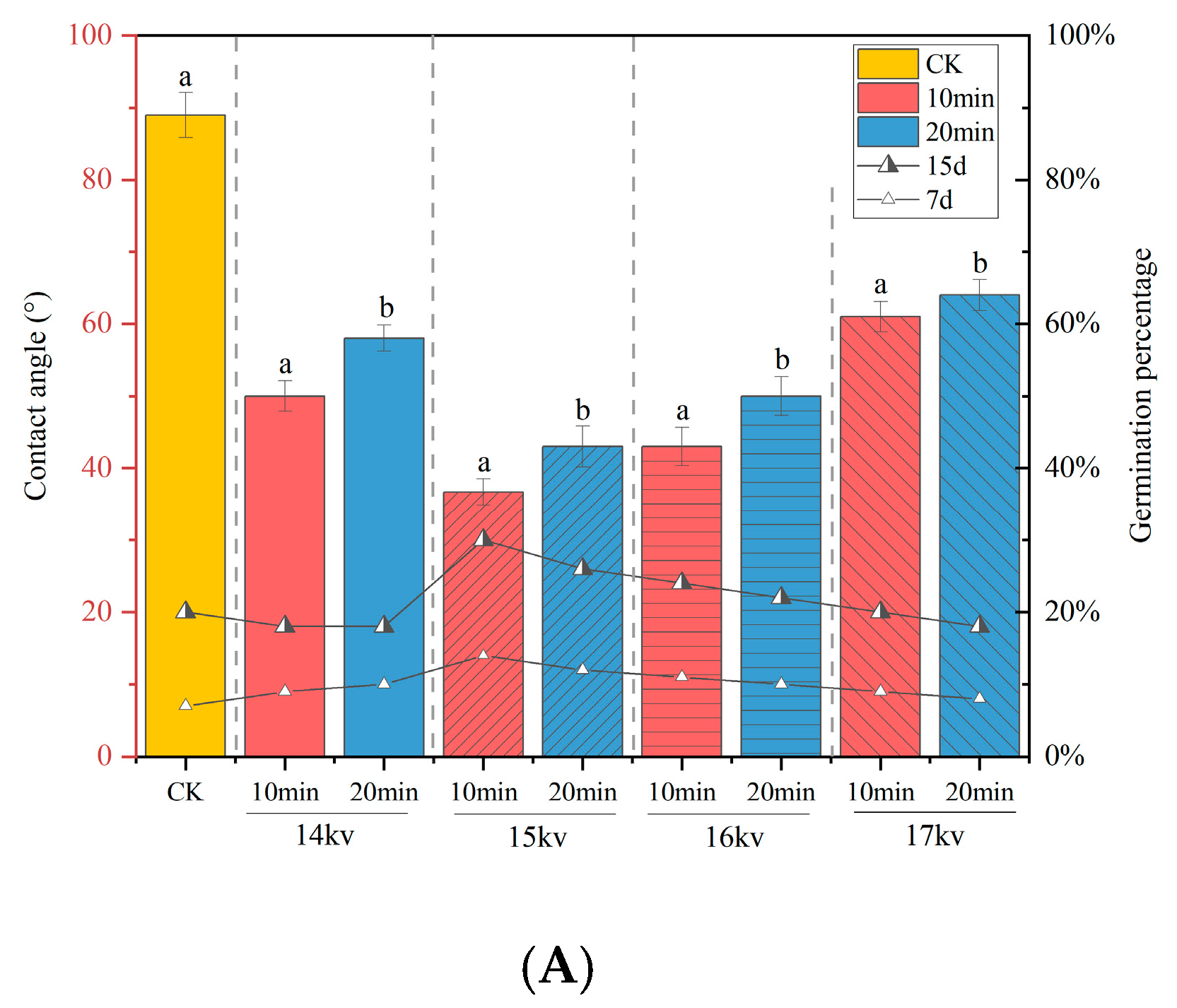
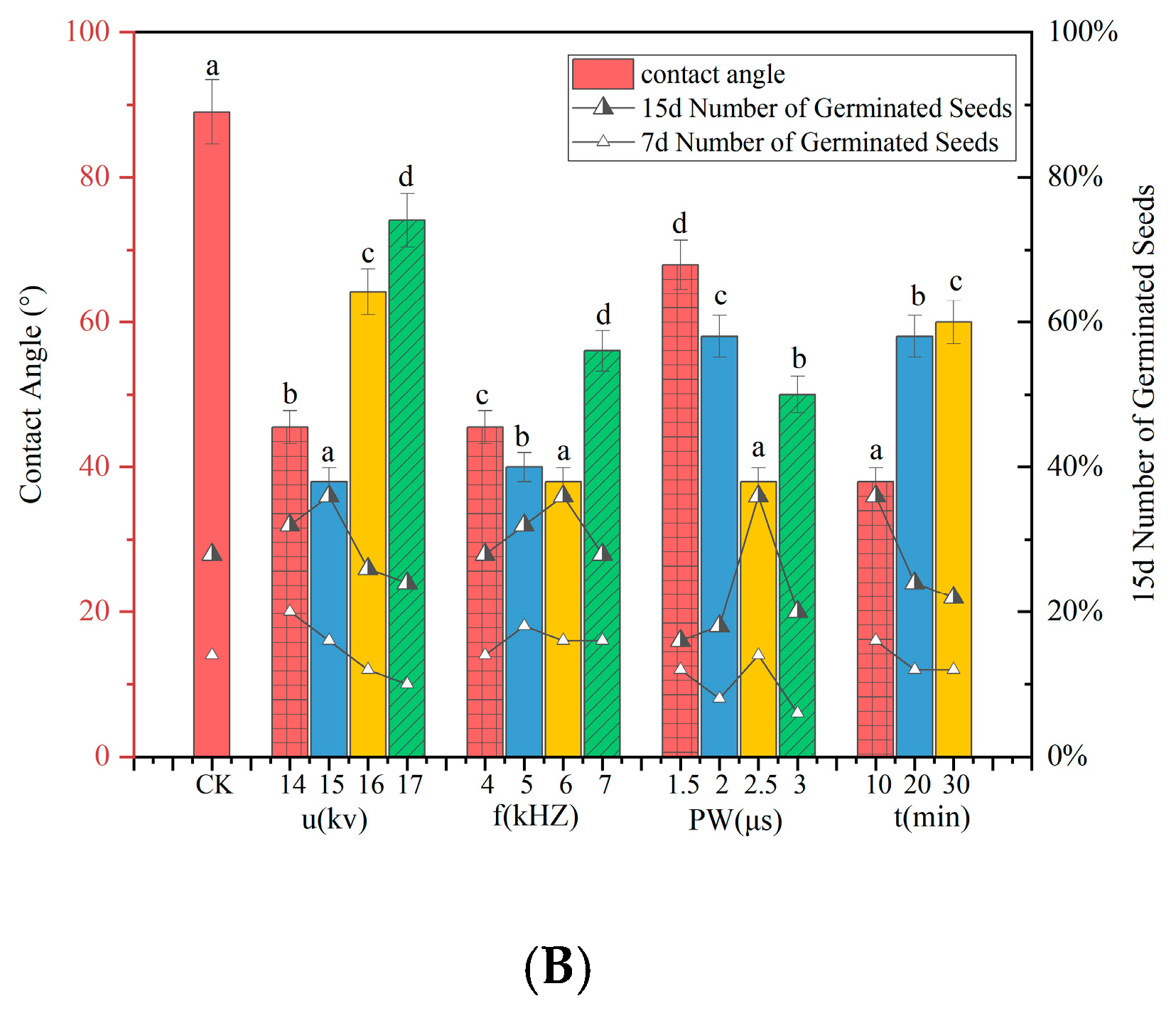

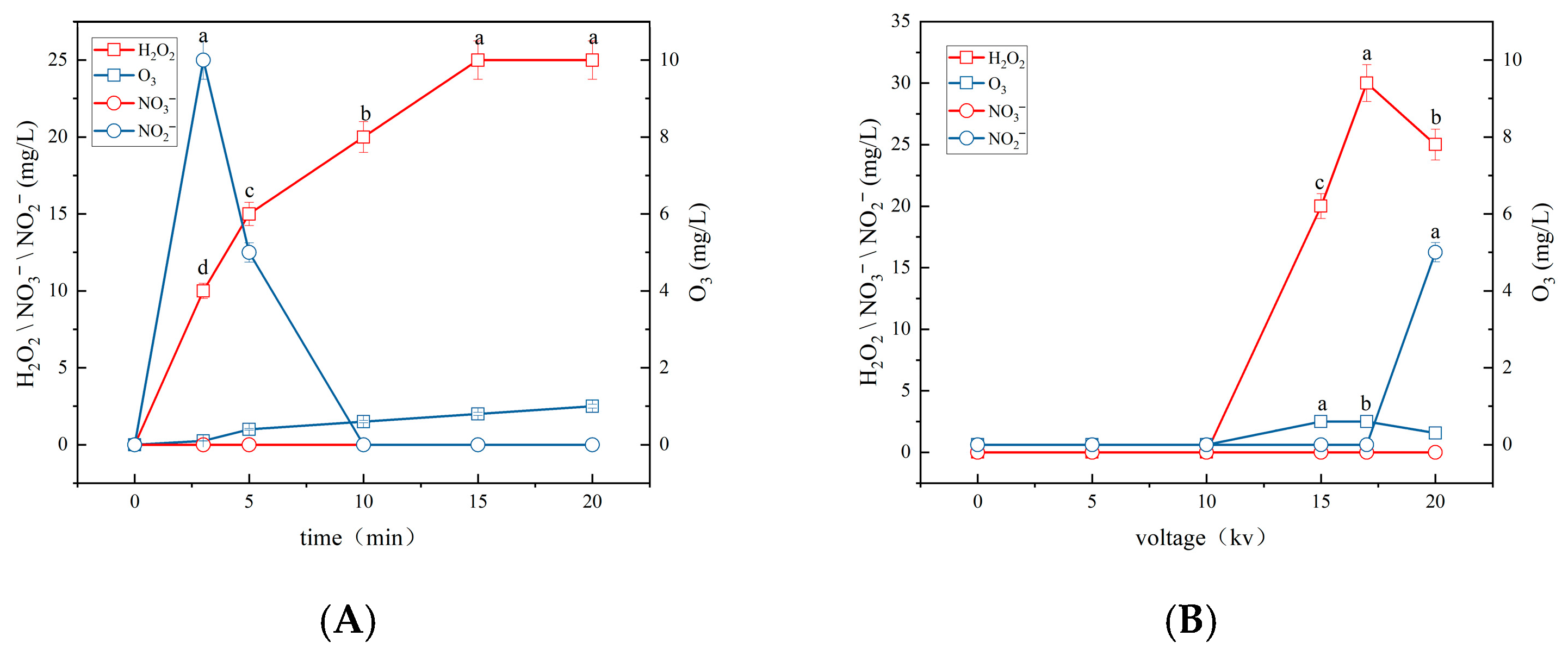
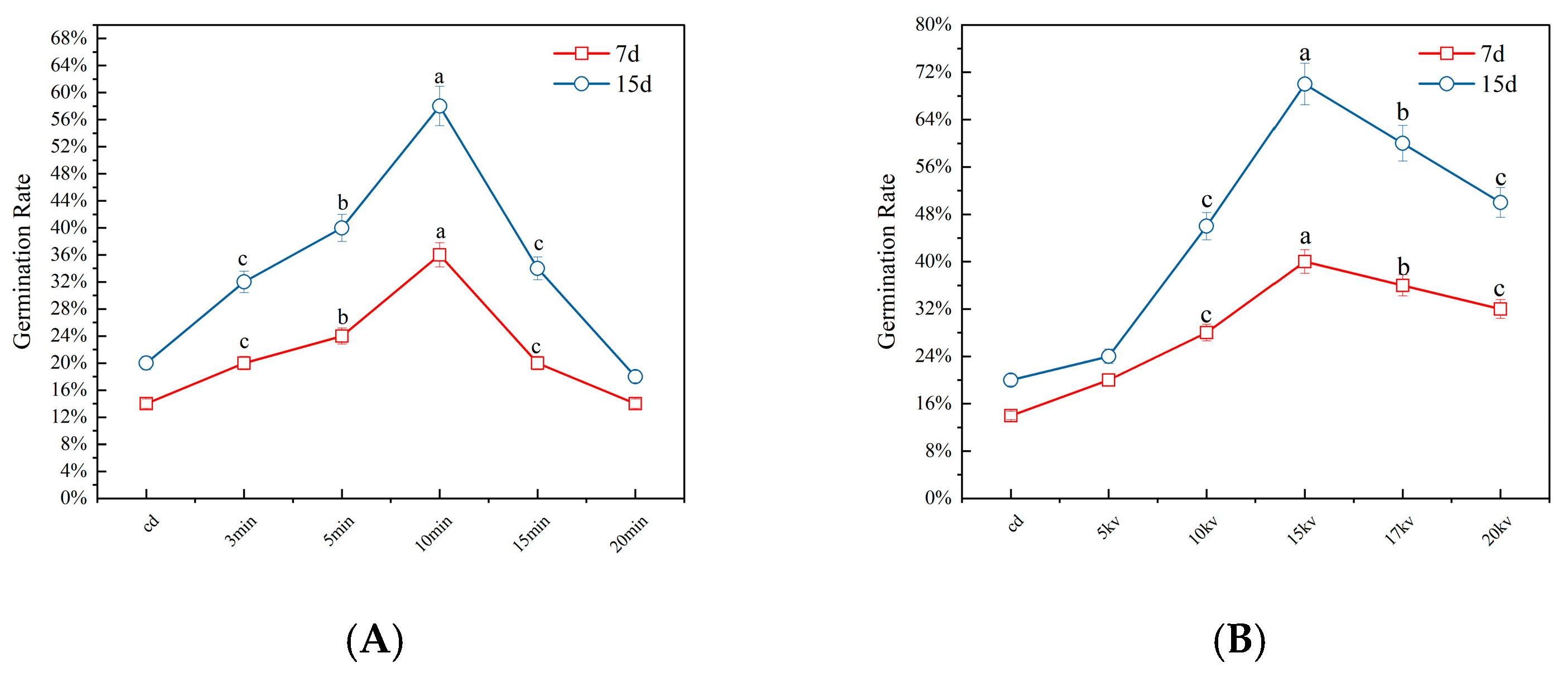

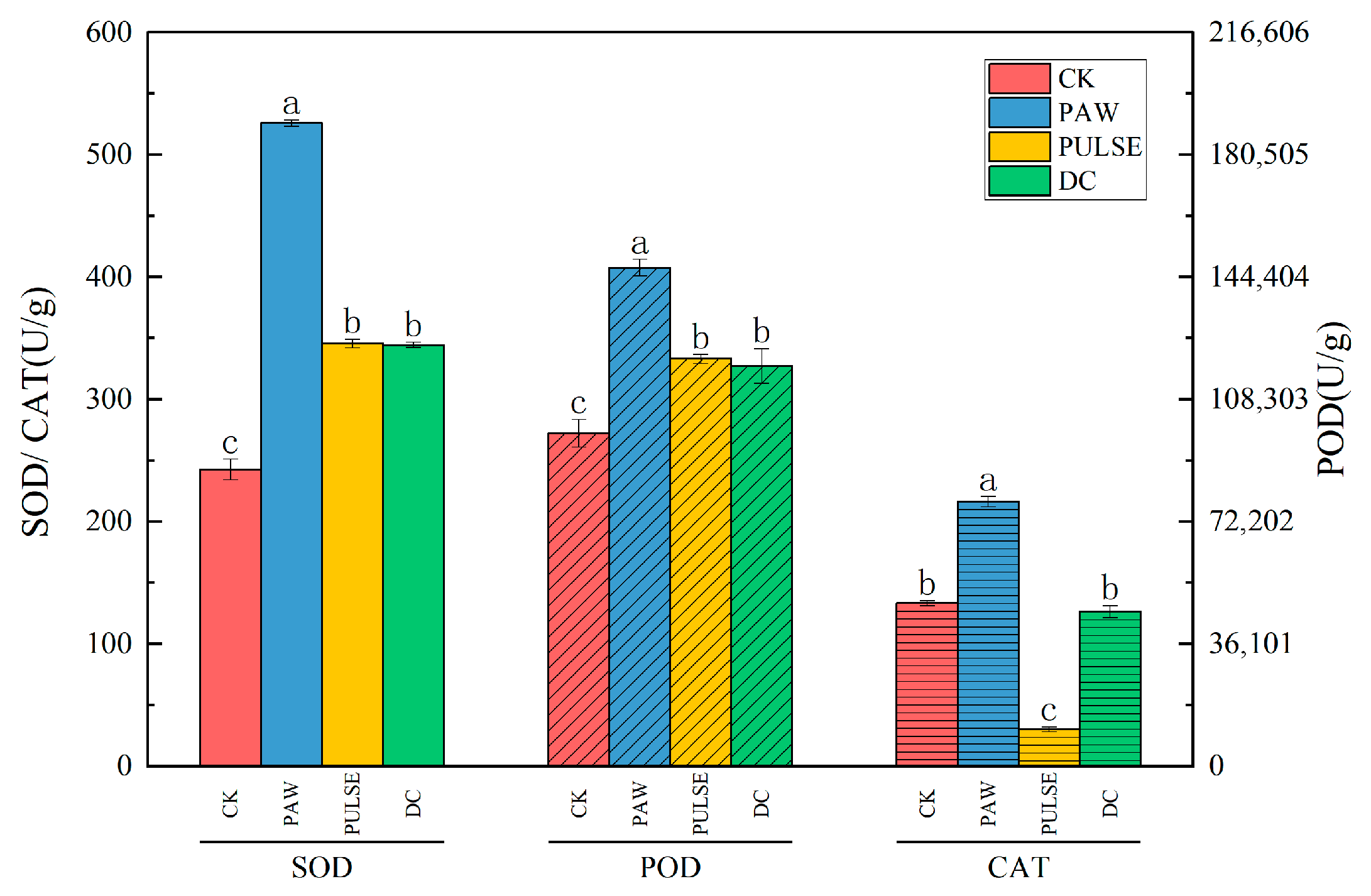
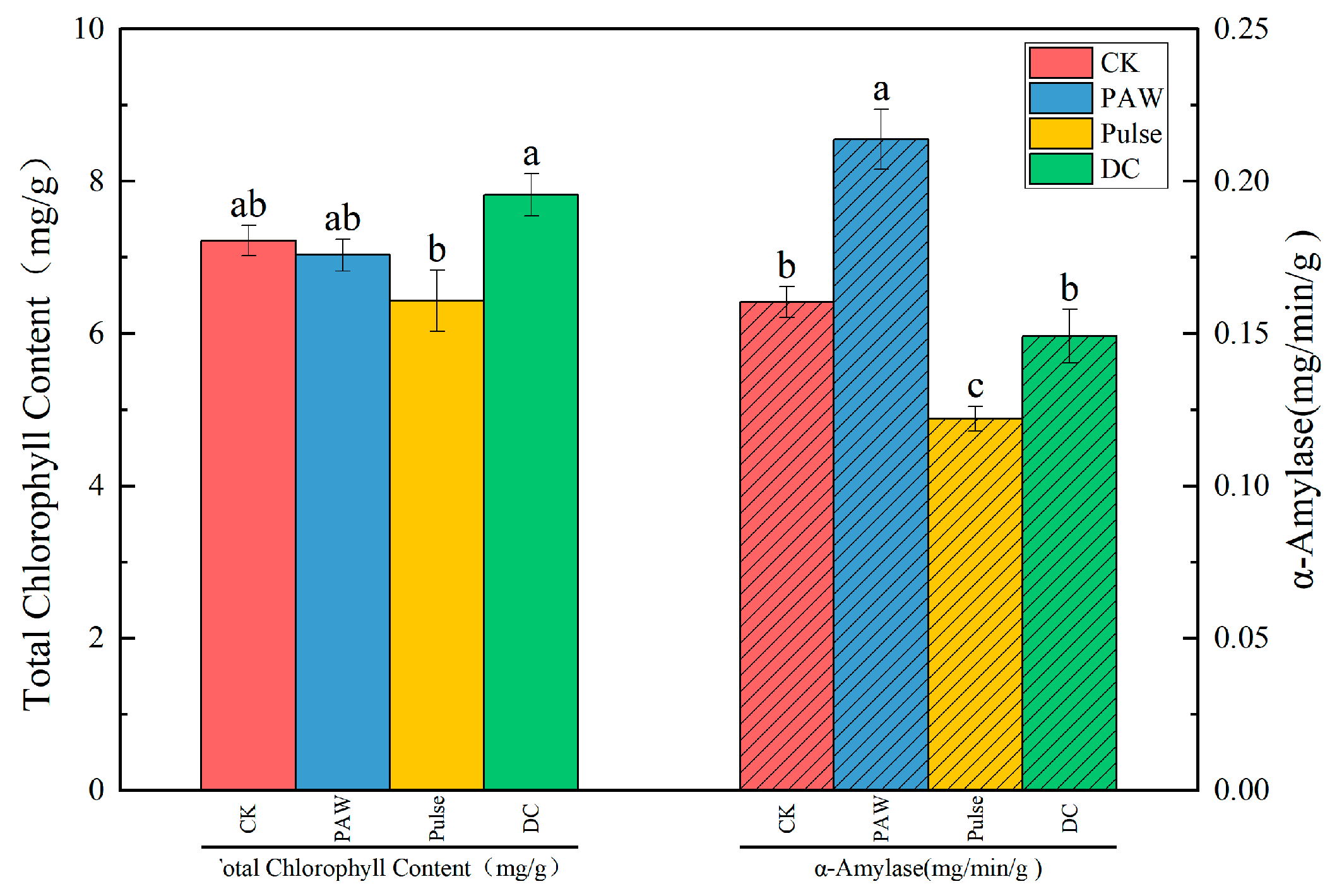
| Parameter | PAW (15 kv, 10 min) | Pulsed (15 kv, 6 kHZ, 2500 ns 10 min) | DC (15 kv, 10 min) | Control |
|---|---|---|---|---|
| Root length (mm) | 9.5 ± 0.7 | 11.5 ± 0.7 | 10.5 ± 0.7 | 9.5 ± 2.1 |
| Seedling length (mm) | 37.5 ± 0.7 | 38.0 ± 3.0 | 40.0 ± 1.4 | 36.5 ± 0.7 |
| Root number (per plant) | 1.5 ± 0.7 | 1.5 ± 0.7 | 1.5 ± 0.7 | 1.5 ± 0.7 |
| Fresh weight (mg/plant) | 44.5 ± 3.5 | 36.5 ± 1.8 | 34.0 ± 4.2 | 27.5 ± 3.5 |
| Dry weight (mg/plant) | 7.0 ± 1.4 | 6.5 ± 0.7 | 5.5 ± 0.7 | 5.5 ± 0.7 |
Disclaimer/Publisher’s Note: The statements, opinions and data contained in all publications are solely those of the individual author(s) and contributor(s) and not of MDPI and/or the editor(s). MDPI and/or the editor(s) disclaim responsibility for any injury to people or property resulting from any ideas, methods, instructions or products referred to in the content. |
© 2025 by the authors. Licensee MDPI, Basel, Switzerland. This article is an open access article distributed under the terms and conditions of the Creative Commons Attribution (CC BY) license (https://creativecommons.org/licenses/by/4.0/).
Share and Cite
Xie, J.; Jin, F.; Ma, S.; Shi, J.; Qi, Y. Effects of Plasma and Activated Water on Biological Characteristics of Bromus inermis Seeds Under Different Power Supply Excitation. Plasma 2025, 8, 43. https://doi.org/10.3390/plasma8040043
Xie J, Jin F, Ma S, Shi J, Qi Y. Effects of Plasma and Activated Water on Biological Characteristics of Bromus inermis Seeds Under Different Power Supply Excitation. Plasma. 2025; 8(4):43. https://doi.org/10.3390/plasma8040043
Chicago/Turabian StyleXie, Jiawen, Fubao Jin, Shangang Ma, Jinqiang Shi, and Yanming Qi. 2025. "Effects of Plasma and Activated Water on Biological Characteristics of Bromus inermis Seeds Under Different Power Supply Excitation" Plasma 8, no. 4: 43. https://doi.org/10.3390/plasma8040043
APA StyleXie, J., Jin, F., Ma, S., Shi, J., & Qi, Y. (2025). Effects of Plasma and Activated Water on Biological Characteristics of Bromus inermis Seeds Under Different Power Supply Excitation. Plasma, 8(4), 43. https://doi.org/10.3390/plasma8040043






